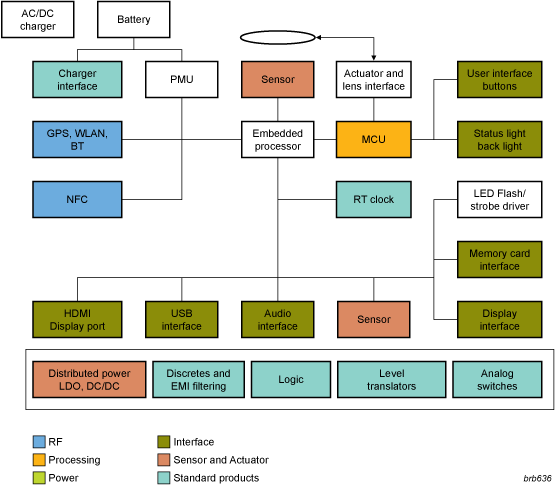
Over the last years, many advanced features such as GPS localization, wireless transmission and a large range of audio and video enhancement possibilities have been added to the camera to enhance the user experience. In addition, image quality has improved drastically, and there is more standardization for data storage and data transfer interfaces, such as memory cards, USB and HDMI.
Memory Card Interfaces
According the IEC61000-4-2 standard, SD host interfaces require additional high-level ESD protection, in addition to the integrated ESDprotection which is typically very weak. Other strict EMI regulations and system requirements, as specified in GSM mobile phones, strongly request filtersthat reduce the radiated/conducted EMI. However, they must still comply with the electrical requirements of the interface specification.
The continuing trend of miniaturization of portable appliances implies that interface devices offering ESD protection and EMI filtering should also integrate biasing circuits/resistors into a single small-sized package. NXP’s memory card interface solutions fully support this continuing trend and offer interface conditioning functions such as high-level ESD protection according the IEC61000-4-2 standard. They also support EMI filtering, integrated biasing resistor networks, regulated power supply to supply SD-memory cards directly from a battery, and voltage level translation to enable the use of low-voltage host processors to communicate with 2.7 V to 3.6 V compliant SD-memory card devices.
GPS LNA
There is an increase in multiple RF frequency and RF system integration into portable appliances at the request of the consumers. The need for higher performance requires maximum sensitivity from receiver antennas without being disturbed by jammers and other disturbances from different RF systems. NXP’s LNA require an industry minimum in external components, while offering a top noise and jammer suppression performance.
Housed in an extremely small package, NXPs latest LNA requires only one external matching inductor and one external decoupling capacitor. It adapts itself to the changing environment in response to the presence of different radio systems.
Charger interface
Whether your device is charged via the USB port or a separate charger, it is exposed to incorrect polarity or abnormally high voltages. Any of these two occurrences poses a threat to the charger circuit and the PMU of the mobile device. In addition, the USB/charger port can be subject to ESD strikes and other transient discharges.
NXP offers an application specific portfolio of TVS diodes and ESD arrays, which enable cost efficient protection solutions – ESD, reverse polarity, overvoltage, other transient discharges – with the smallest footprint.
HDMI
The impedance matched (100 ohm differential) TMDS lines are critical for the design of an HDMI interface, with minimal line capacitance to allow maximized EYE openings of the differential signals and robust system level ESD protection. The EYE open pattern test is actively supported by NXP, which is a founding member of the HDMI consortium. Our Authorized Test Center in Caen, France, offers HDMI compliance measurements including TDR and our development teams can assist with the more challenging aspects of HDMI, including HDCP keys.
Our low power HDMI transmitters connect to a 3 x 8 DVI and offer support for CEC and HDCP. It is backward compatible with DVI 1.0 and can be connected to any DVI 1.0 or HDMI sink. Our HMDI ESD protection saves mobile devices from ESD strikes and transient discharges when the HDMI cable is connected between source and sink devices such as TVs, mobile phones, media boxes and other sources.
Diode & Transistors
First leadless package with tin-plated side pads
For additional information, download guide
Download Full Block Diagram Below
Advertisement

Learn more about NXP Semiconductors





